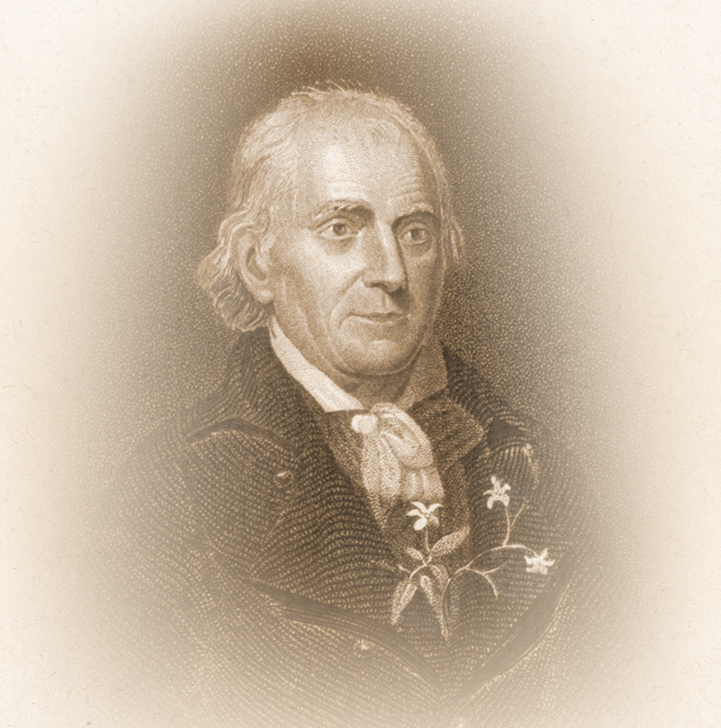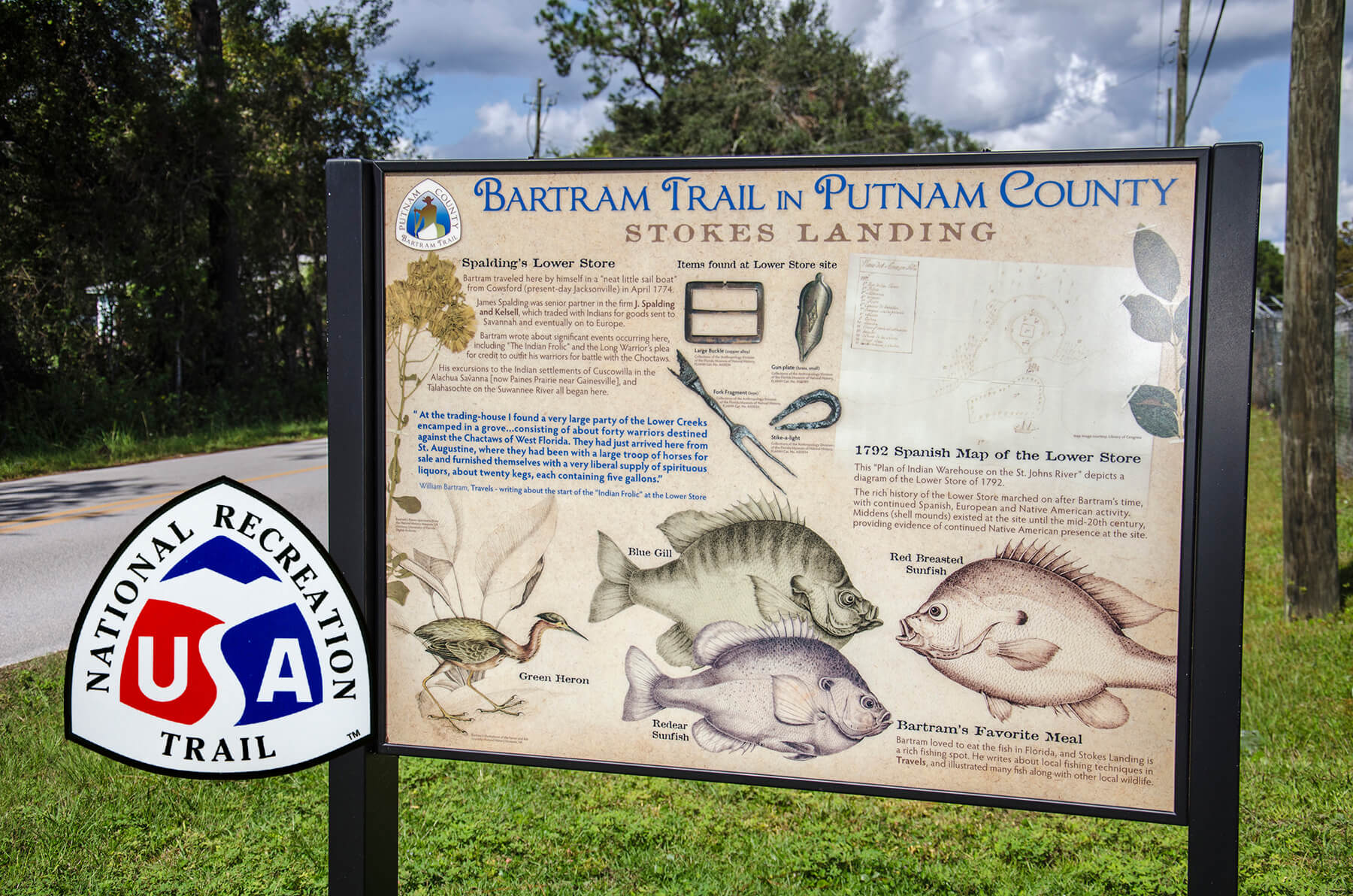William Bartram
Who Was William Bartram?

William Bartram
William Bartram’s exploration of Florida is familiar to people throughout the world, thanks to the publication of his book, Travels, in 1791.
His vivid descriptions of his encounters with the indigenous people and nature at its best and worst, his discovery and illustrations of hitherto undocumented tropical flora and fauna and his eloquent musings made his book a worldwide sensation. William came to Florida in 1765 and again in 1774. His explorations and subsequent writings had a major effect on settlement and subsequent development of Florida.
Bartram Trail in Florida
A Connection to the St. Johns River
The Bartram Trail segment in Putnam County was the first portion of the Bartram Trail in Florida to be developed. A unique feature of this trail is that much of it is traversed by water, with visitors rowing in Bartram’s wake

2013: Inception of the Bartram Trail in Putnam County
The initiative to develop the trail was undertaken by a committee established by the Putnam County Commission. The members of the Committee conducted extensive research into Bartram’s publications and documents as well as the published works of various Bartram scholars and historians to map the route and identify every site known to have been visited by William Bartram during his time in Putnam County.
A grant from the Florida Humanities Council, matched with services provided by the County, enabled the Committed to develop informational brochures, trail signage, informational kiosks, and, most importantly, a Trail website. Once the sites were located, the Committee members obtained permission from private citizens and public agencies to place trail markers at each of the Bartram Sites, making the Bartram Trail a reality.

2016: National Designation
Only four years after Trail development began, the Bartram Trail in Putnam County was designated a National Recreation Trail. The Bartram Trail in Putnam County has since become the hub of the Bartram Trail in Florida and now serves as a template for how other counties can develop the trail within their boundaries.
Learn more at Bartram Trail in Florida.
Historical Context
Below is a brief Timeline showing the historical situation of William and his father John Bartram that lead to their historic travels to Florida.
1763: Need for Documentation of Florida
The Treaty of Paris officially ended the French and Indian or Seven Years War and Spain traded its interest in East Florida to Great Brittan in exchange for Cuba. In order to solidify the claim to this new territory Great Brittan needed to attract settlers and to accomplish this, they needed to catalog and publicize its many virtues.
1765 – 1766: Initial Trip to Florida
James Grant, the newly appointed Territorial Governor commissioned John Bartram, Botanist to King George III, to explore East Florida and draft a report of his findings. John and his twenty-six-year-old son William, began their journey up the St. Johns River on December 19, 1765 and returned to their starting point on February 13, 1766.
The two-month-long journey extended 215 miles up the St. Johns before leaving the River into an easterly chain of lakes and then returning to the River and following it back to its mouth at the Atlantic Ocean. The entire trip was chronicled in the 66-year-old John Bartram’s diary. This portion of his diary was submitted to Governor Grant and later published in England as John Bartram’s Journal. The Journal contained a day-by-day account of the Bartram’s journey and a detailed catalog of the resources and descriptions of its natural systems they encountered.
Following their survey of East Florida, John Bartram returned home to Philadelphia. William decided to stay in Florida and try his hand as a plantation owner. This endeavor failed miserably and within a year he followed his father home. Florida had not lost its allure for William, and he longed to return and continue his explorations.
1774: William Returns to Florida
Financed by wealthy English benefactor, Dr. John Fothergill, William was able to fulfill his longing. In mid-April, 1774 he returned to Florida and the St. Johns River. William did not venture quite as far up the River during this second trip; proceeding only as far as present-day Blue Springs in Volusia County. However, during this period he made Spalding’s Lower Store his base of operations and from here made two shorter trips up the River and ranged more widely, departing from the River’s corridor to explore overland, the western part of the Territory.
He concluded his second tour of East Florida in November of the same year and continued his journey west as far as the Mississippi River.
Resources
William Bartram made two visits to Florida; one in 1765 and another in 1774. These trips were chronicled in 3 publications:
- A diary kept by John Bartram, William’s father, during their trip to East Florida at the bequest of the new Territorial Governor. An excerpt was published as John Bartram’s Journal and its purpose was to attract immigrants and investors to the newly acquired East Florida Territory.
- William Bartram’s Report written for his benefactor Dr. John Fothergill and was not intended for publication but rather to satisfy Dr. Fothergill’s desire to learn more about the natural history of East Florida.
- William Bartram is best-known for his book, “The Travels of William Bartram…” (referred to as “Travels”) and it chronicles his several-years-long journey through what its today the southeastern United States.
Thanks to these documents, and the work of many scholars, historians, and Bartram aficionados, the meanderings of William Bartram in Florida can still be traced, and therefore followed, today.
Below is a list of key books to start with for those interested in digging further into the history of William & John Bartram in Florida.
More Resources Coming Soon…